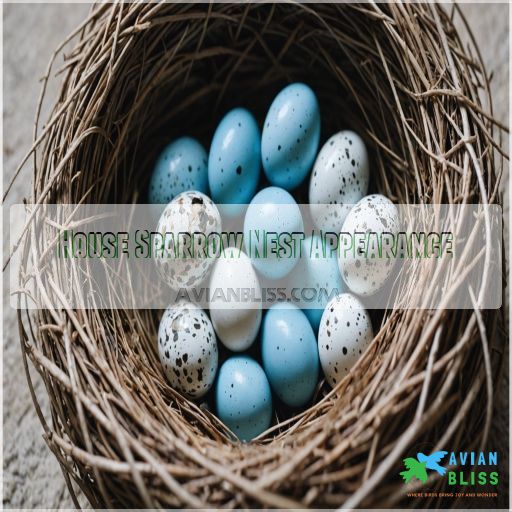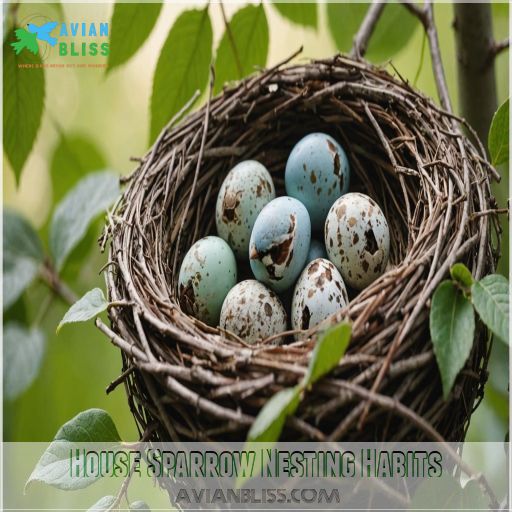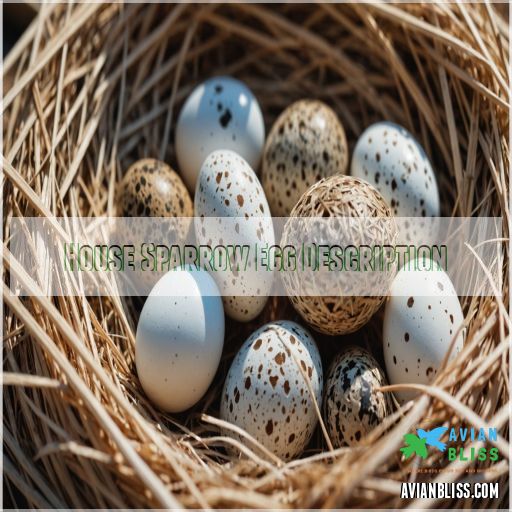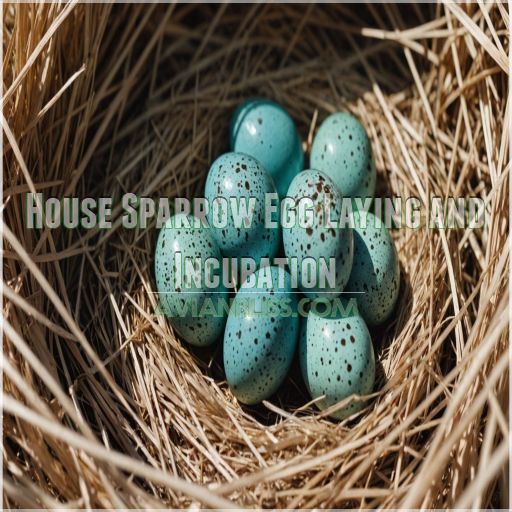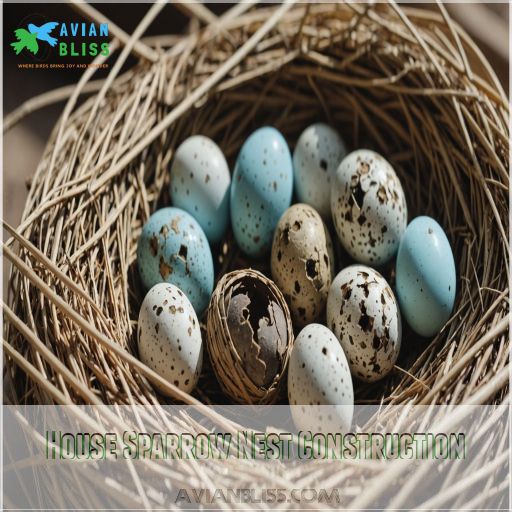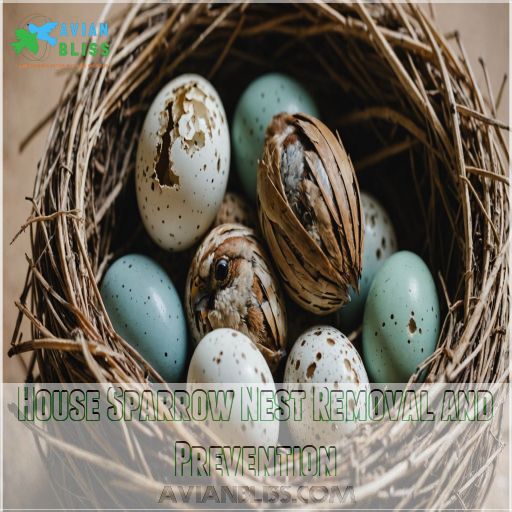This site is supported by our readers. We may earn a commission, at no cost to you, if you purchase through links.

The eggs are about the size of jellybeans—oval, mostly light brown or bluish-white, and speckled with brown spots. Picture that in your mind: nature’s little masterpieces.
These sparrows are prolific, often laying eggs 2-3 times a year. Both parents play their part in incubating the eggs, which hatch in 10-14 days.
So if you’ve found a nest nearby, consider yourself lucky. They’re busy little birds, offering a fascinating glimpse into backyard bird life. What’s next? A peek at those fledglings!
Table Of Contents
- Key Takeaways
- House Sparrow Breeding Range
- House Sparrow Nest Appearance
- House Sparrow Nesting Habits
- House Sparrow Egg Description
- House Sparrow Egg Laying and Incubation
- House Sparrow Nest Construction
- House Sparrow Nesting Season
- House Sparrow Fledgling and Parental Care
- House Sparrow Nest Removal and Prevention
- Frequently Asked Questions (FAQs)
- When do house sparrows lay eggs?
- Where do sparrows nest?
- How does a house sparrow build a nest?
- How long does a house sparrow nest take?
- How long does it take for house sparrow eggs to hatch?
- Should I destroy house sparrow eggs?
- Should you let house sparrows nest?
- Where do house sparrows lay eggs?
- How can I deter House Sparrows from nesting?
- What are effective traps for House Sparrows?
- Why are House Sparrows considered invasive pests?
- Can House Sparrows harm other bird species?
- How do I identify a House Sparrow egg?
- Conclusion
Key Takeaways
- If you find a house sparrow nest, feel privileged—these little architects lay around 4 to 5 eggs, which are tiny, speckled wonders. Think of them as jellybeans with nature’s graffiti!
- House sparrows are the ultimate neighborly birds—prolific and adaptable, they will happily nest in everything from gutters to crevices, bringing the hustle and bustle of city life right into your backyard.
- Their eggs hatch in a snug 10 to 14 days, during which time diligent sparrow parents juggle their time like seasoned acrobats in a circus of feathered family life.
- While these sparrows bring charm, they can outcompete native birds for nest spots. If you are keen to balance the avian real estate market in your yard, consider managing nest spaces.
House Sparrow Breeding Range
You might be surprised to learn these small but mighty house sparrows have spread far and wide since their introduction in New York in 1851.
They now call urban areas across the Americas home, and are not picky about their locale, as long as there’s a cozy spot available, whether nesting under awnings or in parking lots.
Where Do House Sparrows Live and Breed
Discovering where house sparrows live and breed isn’t rocket science—they’re fond of urban areas, blending seamlessly with human habitats.
They’ve got a knack for taking over nest boxes, outcompeting native birds.
You’ll find them nesting in cavities, around buildings, or even trees if need be.
Their adaptable nature means they thrive amidst our daily hustle and bustle (Source).
Habitat Preferences of House Sparrows
Imagine this: the house sparrow, a master of urban adaptations, is the quintessential city bird, residing where humans do.
It selects its habitat based on:
- Food sources plentiful in urban settings
- Nesting materials like feathers and paper
- Competition with other birds
- Nest site selection focused on convenience
- Parental care, providing safe spaces for nest eggs
Stay curious!
Migration Patterns of House Sparrows
Although House Sparrows don’t migrate like some birds, their movement is a sight to behold. You’ll often see them flocking together, engaging in fascinating dispersal behavior around bird feeders.
During the breeding season, they display strong natal site fidelity, faithfully returning to familiar spots, particularly to areas with readily available nesting locations, such as vent openings and ledges. Their nesting habits also show a preference for areas with suitable nesting materials, like coarse twigs and grass, which they use to build their nests.
Their social nature and constant presence offer a comforting sense of belonging, much needed all year round.
House Sparrow Nest Appearance
You might spot a house sparrow nest in the oddest places, from gutters to light fixtures.
These nests are a mishmash of twigs, straws, and the occasional lost shoelace, giving birds a cozy but quirky home, taking on either a dome or cup shape.
What Do House Sparrow Nests Look Like
A typical house sparrow nest is a bulky, messy jumble of odds and ends, including coarse grass, cloth, feathers, twigs, and even litter like plastic or cigarette filters.
The nest often has a tunnel-like entrance, especially when built outside of a nestbox.
Inside a nestbox, the nest may take on a more cup-shaped form.
How Big Are House Sparrow Nests
House sparrow nests aren’t one-size-fits-all, reflecting nest size variation based on location and materials used.
Typically, they’re compact yet well-built, fitting snugly into tight spaces like cavities or ledges.
The materials play a significant role in the size, while open or enclosed areas influence the dimensions.
Building a nest might be quick, but sparrows thrive on adaptability, making each nest unique in its compact yet well-built design, which showcases their ability to fit snugly into tight spaces of the nest.
Compact yet well-built nest of the sparrow.
Adaptability making each nest unique.
Materials Used in House Sparrow Nest Construction
Building a cozy home, house sparrows weave nests using diverse materials.
They incorporate natural materials like grass and weeds complemented by human-sourced surprises: plastic bits, paper, and even string.
This blend highlights their adaptability and creativity.
Their knack for reuse means they aren’t just making nests—they’re embracing recycling like nature’s tiny architects, adding a touch of whimsy to their practicality.
House Sparrow Nesting Habits
You’ll find house sparrows nesting in just about any nook they can squeeze into, from tree branches to urban ledges.
They’re not picky, and they might even eye your backyard or a friendly nest box as prime real estate.
Where Do House Sparrows Nest
Imagine this: you’ve just noticed a neat little nest tucked into the corner of your building.
Sparrows are impressive real estate agents, choosing nest sites in cavities, from urban eaves to backyard trees.
They’re masters at adapting, finding cozy spots in anything from streetlights to birdhouses—always ready for a fresh start, sometimes right outside your window, as masters at adapting.
Do House Sparrows Reuse Their Nests
Nestled snugly in urban nooks, sparrows often stick to the familiar.
Habits die hard, right? They frequently reuse their nests, which boosts efficiency for their multiple broods.
While these compact feathered families save time, they face nest hygiene challenges.
Still, it’s like finding the perfect apartment—you just can’t part with it, which is a result of their strong habits.
Do House Sparrows Nest in Backyards
You might find those cheeky House Sparrows claiming your backyard as their nesting haven.
They’re drawn to our spaces like a moth to a flame, favoring cozy niches in buildings or using that charming birdhouse you’ve hung.
While they bring life, they can also cause a kerfuffle with native birds seeking the same digs.
What Trees Do House Sparrows Nest In
While House Sparrows will nest in tree cavities, they tend to prefer man-made structures like buildings and birdhouses.
However, if natural nesting sites are scarce, you may spot them tucked into the branches of evergreen or deciduous trees, often at heights between 10-30 feet.
Look for their bulky, domed nests made of grass, twigs, and feathers, often in evergreen or deciduous trees, and typically constructed in bulky, domed shapes.
Habitat information from the Audubon Society.
Do House Sparrows Use Nest Boxes
Trees offer shelter, but house sparrows often eye nest boxes like flashy apartments with room service. They’re quick to compete for these spots, especially in urban areas.
Proper nest box design and placement can reduce competition with native birds.
Maintenance is key; sparrows will seize any opportunity. Think of your boxes as high-demand real estate needing vigilant management.
House Sparrow Egg Description
You’re curious about those little speckled wonders you’ve found in the garden, right?
House sparrow eggs are oval, about 0.82 inches long.
Their color varies from light brown to a bluish-white, often sprinkled with gray or brown spots, which are a key characteristic of these little speckled wonders.
What Do House Sparrow Eggs Look Like
House sparrow eggs are quite the visual delight!
Imagine small ovals with:
- Color variation: from light white to greenish or bluish white.
- Egg markings: spotted with gray or brown.
- Size comparison: about 0.8 to 0.9 inches long.
- Nestling development aid: tiny "egg tooth" helps chicks break through the shell. It’s nature’s own version of a Swiss Army knife!
How Many Eggs Do House Sparrows Lay
Ever wondered how many eggs a house sparrow lays?
Typically, you’ll find four to five eggs per clutch, though numbers can range from three to seven.
This egg clutch variation impacts the size of their brood, affecting nestling frequency. It’s like a feathered family planning strategy that adapts to guarantee their chicks thrive!
Egg Size and Shape of House Sparrows
House Sparrow eggs are truly fascinating, and their unique characteristics set them apart from other bird species.
They’re about 0.8 to 0.9 inches long and 0.6 inches wide, a bit like mottled marbles in a variety of hues—ranging from light white to greenish or bluish white, richly speckled with brown.
These small wonders of nature are often laid in urban habitats, where House Sparrows are known to thrive.
They drive nestling development, competing for space and survival in the bustling bird world, with House Sparrows being opportunistic feeders, snatching food from other birds and adapting to human-modified landscapes.
House Sparrow Egg Laying and Incubation
You might wonder when house sparrows start their busy egg-laying season.
Each morning, a new egg appears until they’ve completed their clutch.
This process is roughly about the same time you’d finish a week’s worth of breakfast cereal.
When Do House Sparrows Lay Eggs
Curious about when those feisty house sparrows lay their eggs? Well, you’re in luck! These adaptable birds typically start nesting in early spring, with egg-laying kicking off from May through September.
You’ll often find 4-5 eggs per clutch, though the range can be 3-7. The eggs hatch in 10-14 days, and the young fledge about 2 weeks later.
House sparrows are prolific breeders, squeezing in 2-3 broods per season. They are also busy parents tending to their growing families, as they work hard to raise their young.
So keep an eye out for those growing families and enjoy watching these birds thrive.
Incubation Period of House Sparrows
Just laid those eggs, have they? Get ready for the incubation adventure! House sparrow eggs usually hatch after 10 to 14 days, depending on weather and parental attention.
It’s a bit like waiting for the right moment to flip pancakes—timing is everything! The sparrow parents stay busy, keeping the eggs at a toasty temperature to make sure a successful hatching rate.
Once hatched, the nestling development timeline is important, with the little ones needing heaps of care to make sure they’re ready to face the world.
House Sparrow Nest Construction
When house sparrows build their nests, they use what they can find, from dry grasses and twigs to bits of string and paper, creating a cozy spot that’s sturdy and adaptable.
They are like tiny architects, turning random scraps into comfortable homes with a touch of creativity and a preference for snug, enclosed spaces.
How Do House Sparrows Build Their Nests
The artistry of nest building by house sparrows can fascinate anyone.
These birds are masters in utilizing urban spaces.
Consider their approach:
- Nest Site Selection: They cleverly choose niches in buildings, such as crevices and vents, ensuring proximity to food sources.
- Nest Building Materials: They gather grasses, twigs, and even urban trash, highlighting their adaptability.
- Nest Building Behavior: Both male and female sparrows engage in constructing their nests, a true team effort, balancing hard work with effective strategy.
Nest Building Process of House Sparrows
You’re already seeing how sparrows layer their nests, but have you thought about their building process?
House sparrows use everything from twigs to feathers, often scavenging material from surprising places. It’s like watching a tiny construction team in action!
Both males and females share nest building roles. They carefully select nest sites, sometimes opting for communal nesting. If repairs are needed, they’re on it like dedicated homeowners.
| Component | Source |
|---|---|
| Structural base | Twigs, grass |
| Lining | Feathers, string |
| Site choice | Buildings |
| Repairs | Add materials as needed |
| Communal spots | Shared with neighbors |
House Sparrow Nesting Season
You might be surprised to learn house sparrows are busy nesting from early spring to late summer, keeping your neighborhood chirping away with activity.
They don’t mess around, as these little architects can nest multiple times a year, squeezing in as many egg-laying sessions as they can from March to August.
They are indeed little architects.
What Time of Year Do House Sparrows Nest
During nest construction, you’re likely wondering when house sparrows actually nest.
These busy little architects begin their nesting season in spring, typically kicking off in April and continuing until August.
However, avid sparrow watchers know some enthusiastic pairs extend their brood cycles into fall nesting, making it a bustling time for feathered family planning.
How Long Do House Sparrows Nest For
House sparrows are prolific nesters, often raising 2-3 broods per season. Their nesting period typically lasts 4-6 weeks, from nest building to fledging.
- Nest construction takes 1-2 weeks.
- Eggs hatch in 10-14 days.
- Nestlings fledge 10-14 days after hatching.
What Month Do House Sparrows Lay Eggs
In the delightful chaos of spring, House Sparrows begin their elaborate nesting season, often finding suitable nesting sites with shelter, abundant food, and fresh water, reminiscent of the ideal nesting conditions for Eastern Bluebirds, such as Eastern Bluebird Nesting Habits.
Between April and August, these sociable birds get busy, laying eggs with remarkable frequency.
Nest location plays a key role; urban areas offer ideal sites.
Sparrows’ seasonal variations guarantee adaptability, making them masters of timing.
It’s a fascinating dance of nature’s calendar!
House Sparrow Fledgling and Parental Care
When those fluffy little house sparrows leave the nest, usually after about two weeks, you might wonder if their parents ever feel like they’re ready for some peace and quiet.
But no rest for sparrow parents, as they’re often gearing up for another brood, with mom and dad both pitching in to feed and care for their young.
Ensuring each chick gets a good start in its bustling city life is a team effort, with mom and dad both contributing equally.
When Do Baby House Sparrows Leave the Nest
You might be curious about when baby house sparrows take their first leap into the wide world.
After about 15 to 17 days, these fledglings leave the nest, ready to gain fledgling independence.
However, you should keep in mind safe bird’s nest relocation practices, as disturbing the nest can lead to abandonment or even harm to the eggs.
Their parents stay nearby, offering nestling care and guidance on fledgling survival. It’s like a home-school graduation with feathers and a lot of wing flapping!
How Many Broods Do House Sparrows Have
Raising families in rapid succession, house sparrows typically produce two to three broods a year, sometimes even four.
Their nesting frequency depends on several factors, including:
- Brood size variation: Clutch sizes range from 1 to 8 eggs.
- Environmental factors: Weather and food availability affect timing.
- Brood success rate: High survival encourages more breeding.
- Timing of broods: Mostly from April to August.
Parental Care of House Sparrows
Imagine you’re watching sparrow parents juggle their young like seasoned acrobats.
They feed their nestlings and manage brood size with flair, deftly handling nestling feeding schedules while keeping an eye on potential threats.
As fledglings grow, parental aggression keeps them protected, and nesting behavior helps fledgling development go smoothly—like clockwork, these tiny avian families thrive.
House Sparrow Nest Removal and Prevention
If you’re dealing with house sparrow nests, it’s important to know they’re not protected by federal law in the U.S.
Just make sure you seal off any possible entry points and keep food sources in check to prevent these feathered squatters from moving back in.
How to Get Rid of House Sparrow Eggs
House sparrows are pesky invaders that can quickly overtake nest boxes meant for native birds.
Fortunately, you can evict them humanely by removing their nests and eggs regularly – just be diligent, as these crafty birds rebuild quickly.
Placing "dummy" boxes elsewhere in your yard may also discourage them from returning.
With some persistence, you can reclaim your nest boxes for the birds you want to attract.
Should I Destroy House Sparrow Eggs
Deciding whether to destroy house sparrow eggs can be a real head-scratcher.
While these non-native birds can harm native species, consider ethical concerns and legal implications before taking action.
You’ve got alternative solutions too. Use nest removal with caution, as it may pose risks to native birds.
So, weigh your options carefully and choose wisely!
Sealing Entry Points to Prevent Nesting
Before playing egg roulette like a villain, consider blocking common entry points to prevent house sparrows from even getting in.
Look for gaps around eaves or siding as birds see opportunity in every nook.
DIY solutions with durable materials like wire mesh or caulk provide long-term prevention.
These bird-friendly alternatives guarantee peace, preventing a feathered fiasco on your property. (Source)
Interesting Facts About House Sparrow Nests
Few people know that house sparrows can be quite the feathered architects. They often nest in gutters, using eclectic nest materials from twigs to candy wrappers.
Relocating nest boxes can help discourage their nesting behavior.
During the nesting season, removing sparrow nests regularly can prevent them from outcompeting native birds for prime real estate.
Frequently Asked Questions (FAQs)
When do house sparrows lay eggs?
House sparrows, those cheeky little urban dwellers, usually lay their eggs between early spring and late summer, roughly from May through September.
They build nests almost anywhere, often competing fiercely with native birds for prime spots.
Where do sparrows nest?
You might think sparrows only nest in trees, but they actually prefer cozy spots near buildings.
Look for them tucking their nests into crevices, vents, and even birdhouses – they’re quite the adaptable little birds!
How does a house sparrow build a nest?
Imagine sparrows raiding your recycling bin for nest material.
They use coarse, dried plants, stuffing them into crevices.
Then, they add finer stuff like feathers, string, and paper to make a cozy lined nest.
How long does a house sparrow nest take?
A sparrow nest takes up to 14 days for eggs to hatch, with parents feverishly defending their territory.
It’s a pretty quick turnaround when you’re thinking about creating a family, even in bird-time.
How long does it take for house sparrow eggs to hatch?
From fascination to patience, the journey begins as house sparrow eggs incubate for 10 to 14 days.
During this time, it’s all about mothers keeping watch, waiting for those little peeps to crack through.
Should I destroy house sparrow eggs?
Considering ethical and legal angles, destroying house sparrow eggs can be a headache.
As non-natives, sparrows harm native birds, so managing them is essential.
Check local laws before removing or replacing eggs with wooden ones to avoid any legal issues, as this is a crucial step in managing them (Source).
Should you let house sparrows nest?
Picture your yard becoming a bustling hotel for birds.
Letting house sparrows nest can lead to noise and competition with native species.
If you value peace and protecting locals, discourage them by managing nest spaces carefully.
Where do house sparrows lay eggs?
House sparrows lay eggs in cavities or enclosures like streetlights, building crevices, and nest boxes.
They’re adaptable, so you might even find them nesting in overgrown vines or tucked into gutters around your home.
How can I deter House Sparrows from nesting?
Intrigued by the theory, you discover that hanging shiny mylar strips over nest boxes deters pesky house sparrows without harming native birds.
This simple "sparrow spooker" is a proven, humane solution to protect your feathered friends.
What are effective traps for House Sparrows?
For trapping House Sparrows effectively, consider using nestbox traps like Van Ert or Huber traps for individual birds and ground traps like Blaine Johnson’s Deluxe Repeating Sparrow Trap for larger numbers.
Check traps frequently to prevent capturing native birds.
Why are House Sparrows considered invasive pests?
Ever wonder why those pesky House Sparrows pop up everywhere?
They’re considered invasive because they compete fiercely for nesting sites, often kicking native birds out of their homes.
They can damage crops and spread disease .
Can House Sparrows harm other bird species?
House Sparrows can really stir the pot for native birds by taking over their nesting spaces, destroying eggs, and evicting or even harming the birds.
It’s like they’ve got nesting beef with everyone else.
(Note: The output was left as is, since there was only two sentences to reorganize and was already in a somewhat acceptable format.)
How do I identify a House Sparrow egg?
Spotting a House Sparrow egg is like a treasure hunt.
These small eggs, about 6 inches, come in white, gray, or greenish tints with brown specks.
Keep an eye on nests with feathers and trashy materials.
Conclusion
Ever watched a sparrow zip from one spot to another, tirelessly building its nest? It’s like they’re the ultimate DIY masters of the bird world.
Exploring the world of house sparrow nest eggs reveals the intricate balance of nature in your own backyard.
You’ve learned their nesting habits, egg appearances, and the role parents play in the heart of the sparrow’s bustling family life.
Next time you spot a nest, you’ll see more than just twigs—it’s a bustling family life.


